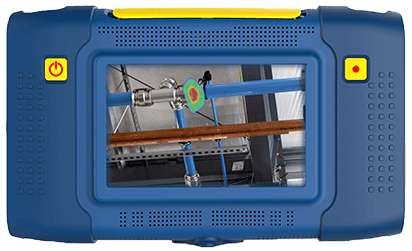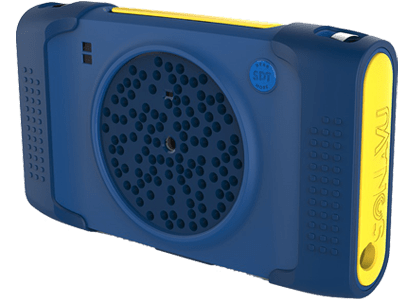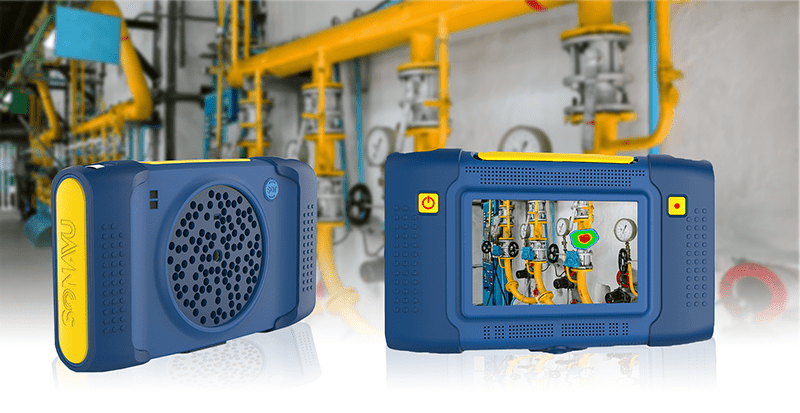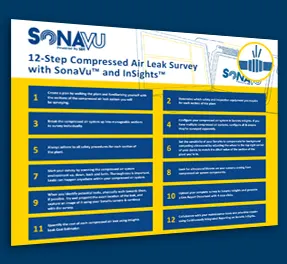SonaVu™
Multi-frequency Ultrasound and Acoustic Imaging Camera
Bring your condition monitoring program into focus.
What is an Acoustic Imaging Camera?
SonaVu™ is an acoustic imaging camera. Using its 112 ultrasound sensors and optical camera, it can detect sources of airborne ultrasound and transmit them into a visual image on its touch screen. Defects such as compressed air system leaks, compressed gas system leaks, vacuum leaks, the presence of partial discharge on electrical assets, and failed/working steam traps all create turbulence. And when there is turbulent flow present, there is airborne ultrasound. SonaVu™ makes the superhuman hearing capabilities of SDT Ultrasound Devices visible to the human eye.

Using an acoustic imaging camera these defects and failure modes can be visualized and pinpointed from up to 50 meters away. And due to the visualization capabilities of SonaVu™, it’s really easy to use too. With minimal device training, maintenance technicians can confidently inspect their assets for defects, long before they cause unexpected downtime.

Compressed Air Leak Management
If it’s been a while since your last ultrasound compressed air survey, or you’ve never even performed a compressed air leak survey at your facility, then it is likely that your compressed air system is riddled with leaks. A poorly maintained compressed air system can negatively impact product quality and slow production efficiency… not to mention majorly impact plant-wide sustainability.

There are several reasons why a leaky compressed air system is low on the priority list for maintenance staff.
- It could be because some don’t associate compressed air with energy consumption.
- It could be because not all maintenance technicians are aware of the fastest and easiest way to locate compressed air leaks.
- It could be because maintenance doesn’t like to take out the ultrasound detector and simply finding leaks, tag them and fix them.
- It could be because we can’t find the time in our busy days to do the little things that require elbow grease like repairing some air leaks and accumulate thousands in energy savings.
The bottom line is – a leaky system will never fulfill production demand, continually drain resources, and harm the environment as additional and unnecessary greenhouse gas emissions accumulate and fill our atmosphere.
With SonaVu™ performing a compressed air leak survey and locating those pesky leaks has never been easier. Also, since SonaVu™ can pinpoint leaks from up to 50 meters away, even leaks hard to reach compressed airlines won’t go undetected.
Electrical Asset Reliability
 Unreliable electrical machines and equipment can cost manufacturers millions of dollars in downtime and repairs. And even more threatening… they have the potential to injure and kill workers without warning. But it doesn’t have to be this way. Before an electrical asset reaches the point where a dangerous phenomenon like arc flash and arc blast can occur, there are tell-tale signs that the asset is becoming unstable. And the biggest key to avoiding these costly and dangerous electrical malfunctions is early detection.
Unreliable electrical machines and equipment can cost manufacturers millions of dollars in downtime and repairs. And even more threatening… they have the potential to injure and kill workers without warning. But it doesn’t have to be this way. Before an electrical asset reaches the point where a dangerous phenomenon like arc flash and arc blast can occur, there are tell-tale signs that the asset is becoming unstable. And the biggest key to avoiding these costly and dangerous electrical malfunctions is early detection.
Partial discharge is the first sign of a deteriorating electrical asset. And the effects of partial discharge produce airborne ultrasound signals, easily detectable with SonaVu™. You can find sources of partial discharge on all types of high voltage electrical assets. Switchgear, transformers, overhead lines, and underground cables to name a few.
By simply scanning these high voltage electrical assets with your SonaVu™ you will be able to locate and document the presence of any partial discharge. Indeed, regular ultrasound inspections on your electrical equipment will reveal partial discharge at its earliest stages and keep factory workers safe.
Reducing Fugitive Emissions
 Fugitive Emissions are a stain on oil and gas production facilities. In many cases, they’re just considered to be part of the industrial process, as they are categorized as equipment leaks and accidents, and equipment failures. But this intentional neglection of fugitive emissions comes at a cost… As they leak into the air we breathe, several dangers can arise. While some fugitive emissions only result in unpleasant odors… Some can pose a serious safety threat to both plant personnel and those living near the facility.
Fugitive Emissions are a stain on oil and gas production facilities. In many cases, they’re just considered to be part of the industrial process, as they are categorized as equipment leaks and accidents, and equipment failures. But this intentional neglection of fugitive emissions comes at a cost… As they leak into the air we breathe, several dangers can arise. While some fugitive emissions only result in unpleasant odors… Some can pose a serious safety threat to both plant personnel and those living near the facility.
SonaVu™ is capable of detecting fugitive emission gas leaks in most environments. When a compressed gas leaks from a high-pressure such as inside a pipe or valve, to a low-pressure zone like our atmosphere, there is a differential pressure created which produces ultrasonic turbulence. Scanning hot zones for fugitive emissions with your SonaVu™ will reveal sources of dangerous and costly leaks. Moreover, inspectors need not worry about scanning for leaks inside or outside, as the ultrasonic detection capabilities of SonaVu™ is not affected by wind.
SonaVu InSights™: Complete Compressed Air Leak Management System
 SonaVu InSights™ is a web application for creating instant reports of compressed air leak and electrical asset surveys performed with the SonaVu Acoustic Imaging Camera from SDT. Document findings, prioritize repairs, estimate cost impact, eliminate energy waste, and save money with this free application. The SonaVu InSights™ Image and Report Library is a secure place to store, organize, analyze, and prioritize your findings with your SonaVu™ Acoustic Imaging Camera.
SonaVu InSights™ is a web application for creating instant reports of compressed air leak and electrical asset surveys performed with the SonaVu Acoustic Imaging Camera from SDT. Document findings, prioritize repairs, estimate cost impact, eliminate energy waste, and save money with this free application. The SonaVu InSights™ Image and Report Library is a secure place to store, organize, analyze, and prioritize your findings with your SonaVu™ Acoustic Imaging Camera.
12-Step Compressed Air Leak Survey with SonaVu™ and InSights™
- Create a plan by walking the plant and familiarizing yourself with sections of the compresed air leak system you will be surveying.
- Determine which safety and inspection equipment you require for each section of the plant.
- Break the compressed air system up into manageable sections to survey individually.
- Configure your compressed air system in SonaVu InSights. If you have multiple compressed air systems, configure all & ensure they’re surveyed separately.
- Always adhere to all safety procedures for each section of the plant.
- Set the sensitivity of your SonaVu to compensate for background competing ultrasound by adjusting the wheel in the top right corner of your device to match the dBuV value of the section of the plant you’re in.
- Start your survey by scanning the compressed air system environment up, down, back and forth. Thoroughness is important. Leaks can happen anywhere within your compressed air system.
- Look for ultrasound blooms on your camera coming from compressed air system components.
- When you identify potential leaks, physically walk towards them, if possible. Try and pinpoint the exact location of the leak, and capture an image of it using your SonaVu camera & continue with the survey.
- Upload your complete survey to SonaVu lnSights and generate a Live Report Document with 4 easy clicks.
- Quantify the cost of each compressed air leak using lnSights Leak Cost Estimator.
- Collaborate with your maintenance team and prioritize repairs using Continuously Integrated Reporting on SonaVu lnSights.








